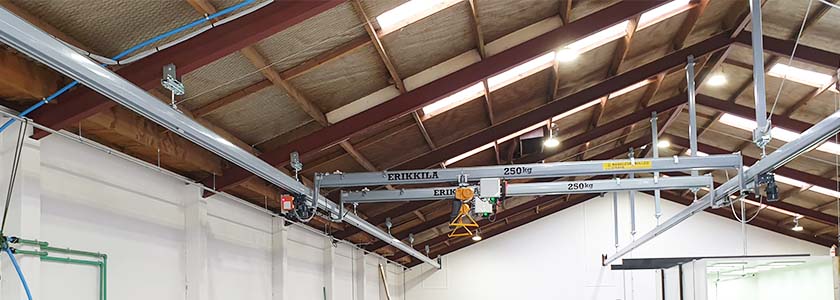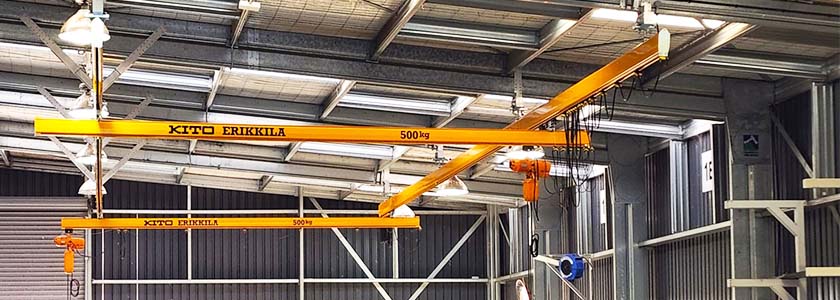Overhead cranes, also known as bridge cranes, along with portable cranes, are some of the most powerful pieces of lifting equipment available to any business. Attached directly to the structure of the building in which they’re installed, an overhead crane is capable of lifting extremely heavy loads.
But exactly how heavy?
There are a few terms that are used to describe overhead crane lifting capacity: maximum rated capacity, manufacturer's rated capacity and working load limit, to name just a few.
In this guide we’ll take a closer look at overhead crane capacities: what they are, how they’re calculated, and how you might use them to identify the right crane for your situation.
What is the capacity of an overhead crane?
The capacity of an overhead crane can be measured a few different ways, but all of these techniques have the same aim: to define the largest and heaviest load that the crane can safely lift and shift for a given configuration or in a given situation.
Overhead crane lift capacity can be measured in two ways:
- Gross capacity: The total weight that the crane is capable of lifting, given structural and material considerations.
- Net capacity/working load limit (WLL): The maximum weight that is able to be safely lifted once capacity deductions (such as the weight of lifting accessories) and the crane’s configuration have been factored in.
The second figure is the most important, as it takes into account the fact that a crane has to bear the weight of not only the loads that it lifts and shifts, but the equipment and accessories that make that lifting and shifting possible.
Most crane manufacturers will nominate the working load limit of every crane they sell (and provide lifting charts for certain cranes) which an operator can use as a guide to the crane's net capacity in specific situations and configurations.
The working load limit of a crane is also limited by any lifting accessory that is used as part of a lift, such as the trolley, lifting hoist, load chain and hook. If any of these accessories has a WLL below that of the crane, the WLL of the entire configuration is brought down to the lowest figure. If, for example, an 80t overhead crane was lifting a load with a load chain rated to 20t, the WLL of the crane would be brought down to 20t.
What other factors affect overhead crane capacity?
A couple of factors affect overhead crane capacity beyond the structure and configuration of the crane itself:
Frequency of use
The more an overhead crane is used, the more opportunity there is for wear and tear, and the more likely the crane is to fail, particularly if it is not properly maintained. Crane duty classification is a measure that combines WLL and frequency of use to help crane buyers choose a piece of equipment that will be able to cope with both the weight of lifts and the frequency at which lifts will be conducted (e.g. 10-20 lifts per hour at an average of 50% of the WLL).
Speed
If you need your overhead crane to move quickly, perhaps in order to avoid it becoming a bottleneck in your factory, warehouse or production facility, this may affect the working load limit of your crane, as heavier loads must be moved slower in order to be moved safely.
Environmental conditions
The environment is another factor. It should also be noted that a crane's working load limit is usually calculated based on a lift in ideal conditions, though given overhead cranes are installed indoors and aren’t concerned with things like lift radius, lift angle and boom extensions, environmental factors don’t usually affect the capacity of these cranes.
How is crane capacity calculated?
Looking for a crane capacity calculator? Thankfully the crane capacity calculation formula is so simple that you may not need one – these are calculations that you can do with any old calculator, or even by hand.
The formula for finding the net capacity/WLL of a crane is:
Gross Capacity – Deductions = Net Capacity
To find your figure, you’ll need to identify all relevant capacity deductions, add them all together, then subtract that deduction total from the gross capacity of your overhead crane.
Remember that you’ll also need to consider the WLL for accessories such as hooks, as the overall WLL will be the lowest WLL of any given part of the crane. For accessories this is calculated using the following formula:
Minimum Breaking Load / Factor of Safety = Working Load Limit
The minimum breaking load is the load that would cause the accessory to fail or permanently weaken or deform. The factor of safety for any given accessory considers things like materials and construction, degradation from wear and corrosion, inspection periods and the effect of dynamic loads.
The working load limit of any piece of lifting equipment or accessory is determined by the manufacturer. If for any reason there is a need to alter the WLL as outlined by the manufacturer, this work must be completed by a qualified engineer in consultation with said manufacturer.
Do overhead cranes have load charts?
A load chart is a chart found on many cranes that describes the weights that the crane is able to lift in different configurations – in short, it tells the operator what a crane is and isn’t capable of.
But you won’t find a load chart on an overhead/bridge crane. The reason is simple: an overhead crane is capable of picking up the same sized load no matter where it is placed within the crane’s footprint.
Load charts are used on cranes with variable radii, like tower cranes, mobile cranes and some jib cranes. These charts take into account factors that impact the lifting capacity of the crane, such as the angle of the boom and how far it is extended, to calculate the WLL in a variety of configurations.
Because an overhead crane is a permanent installation that only ever lifts loads within the bounds of its support columns, and doesn’t have the ability to change lifting angles or extend any of its dimensions, a load chart is not required. The crane operator need only be concerned with the working load limit stated by the manufacturer.
Enabling New Zealand businesses to work smarter, quicker and safer
An overhead crane is far from an everyday purchase. Crane capacity is just one of a wealth of things to consider when shopping for your ideal piece of lifting equipment, and given the size, cost and potential dangers of cranes, it’s critical that you choose right the first time.
If you do choose the perfect crane, the benefits can be incredible. Not only will you enjoy a tidy return on your investment by allowing your business to work more efficiently and productively, you’ll make your workplace safer too, by minimising manual handling and allowing your team to move large loads in a less risky way.
At Stratalign we’ve spent years helping Kiwi businesses identify and secure the lifting equipment that will get them working smarter, faster and safer. If you’re looking to enhance your operations with an overhead or bridge crane that is capable of lifting exactly what you need it to, we’re ready to help.
Get in touch with our expert team today for a no-obligation consultation and quote.



